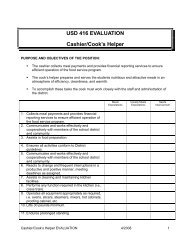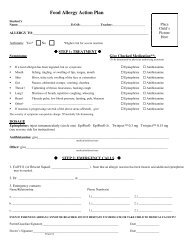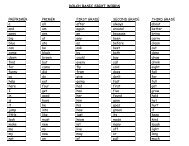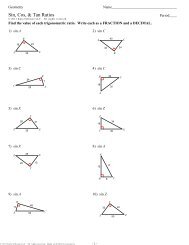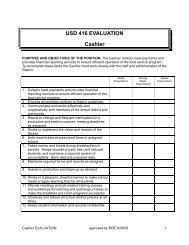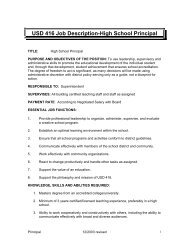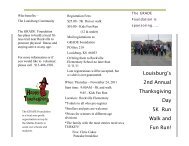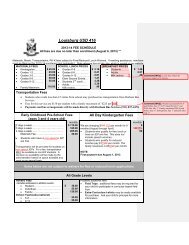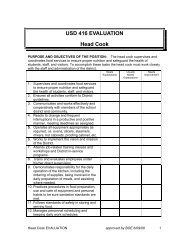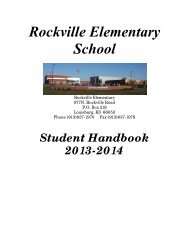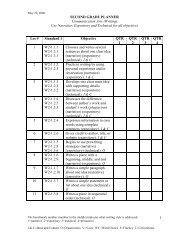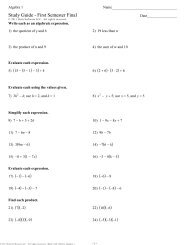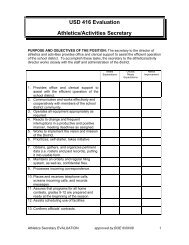Questioning Strategy IDEAS to Use in the Classroom
Questioning Strategy IDEAS to Use in the Classroom
Questioning Strategy IDEAS to Use in the Classroom
You also want an ePaper? Increase the reach of your titles
YUMPU automatically turns print PDFs into web optimized ePapers that Google loves.
Us<strong>in</strong>g Questions With Poetry – Unlock<strong>in</strong>g a poem’s mean<strong>in</strong>gthrough questions leads <strong>to</strong> <strong>in</strong>ferential th<strong>in</strong>k<strong>in</strong>g. The questionsserve as prompts <strong>to</strong> <strong>the</strong> <strong>in</strong>terpretation of <strong>the</strong> poem and <strong>the</strong> <strong>in</strong>ferencesabout its mean<strong>in</strong>g. There are no absolute answers when <strong>in</strong>terpret<strong>in</strong>gpoetry. Langs<strong>to</strong>n Hughes’s poem “Dreams” is a good example of apoem <strong>to</strong> <strong>in</strong>terpret through <strong>the</strong> use of questions.Thick and Th<strong>in</strong> Questions – Thick questions are those that addresslarge, universal concepts and often beg<strong>in</strong> with Why? How Come? Iwonder? Or <strong>the</strong>y address large content areas, such as What ispho<strong>to</strong>syn<strong>the</strong>sis?Th<strong>in</strong> questions are those primarily asked <strong>to</strong> clarify confusion,understand words, or access objective content. Questions that can beanswered with a number or with a simple yes or no fit <strong>in</strong><strong>to</strong> thiscategory. In <strong>the</strong> content areas particularly, <strong>the</strong>se question categories,which separate broad concepts from smaller issues of clarification,seem <strong>to</strong> guide students down <strong>the</strong> path <strong>to</strong> fur<strong>the</strong>r <strong>in</strong>sight.Research Topics from Questions – The easiest way <strong>to</strong> guidestudents <strong>to</strong> focus research <strong>to</strong>pics and pare <strong>the</strong>m down is through <strong>the</strong>irquestions. Three organizational forms that can be used <strong>to</strong> recordquestions for possible research <strong>to</strong>pics are:1. I wonder….. booklet - Is a wide range of <strong>to</strong>pics that <strong>the</strong>student might wonder about. These questions can help narrow abroad <strong>to</strong>pic.2. Questions/Facts – Is a two-column format with questions on<strong>the</strong> left side of <strong>the</strong> paper and answers recorded on <strong>the</strong> right.3. Webb<strong>in</strong>g or Mapp<strong>in</strong>g – Graphic organizers that record <strong>the</strong>questions and answers as <strong>the</strong>y are discovered.Sticky Note Codes – <strong>Use</strong> sticky notes <strong>to</strong> mark places of confusion <strong>in</strong>a text. Students write Huh? on <strong>the</strong> <strong>to</strong>p half of <strong>the</strong> sticky note, leav<strong>in</strong>g<strong>the</strong> bot<strong>to</strong>m half blank. As <strong>the</strong> student cont<strong>in</strong>ues read<strong>in</strong>g or reread<strong>in</strong>g<strong>to</strong> clarify mean<strong>in</strong>g or answer a question, <strong>the</strong>y often clear up <strong>the</strong>irconfusion or f<strong>in</strong>d <strong>the</strong> answer <strong>in</strong> <strong>the</strong> text. At this po<strong>in</strong>t <strong>the</strong>y return <strong>to</strong><strong>the</strong> orig<strong>in</strong>al sticky note and sketch a lightbulb on <strong>the</strong> bot<strong>to</strong>m half of <strong>the</strong>sticky note. This technique supports <strong>the</strong>ir effort <strong>to</strong> moni<strong>to</strong>r <strong>the</strong>ir owncomprehension as <strong>the</strong>y move <strong>to</strong>ward <strong>in</strong>dependence.



